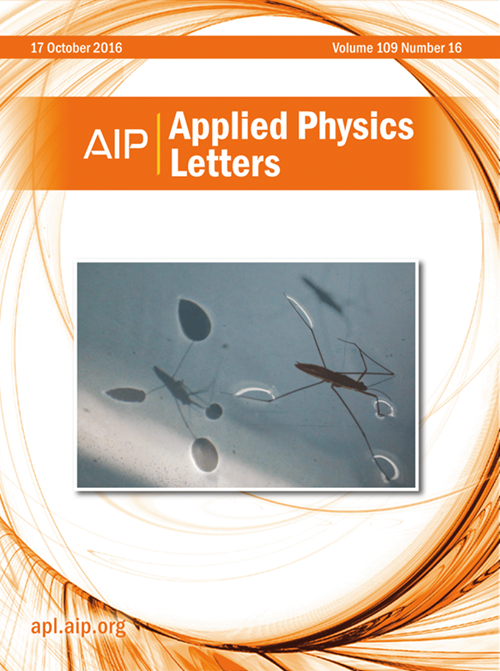用自旋漂移-扩散方程计算薄铝中的高频自旋输运
IF 3.6
2区 物理与天体物理
Q2 PHYSICS, APPLIED
引用次数: 0
摘要
横向自旋阀(LSV)是自旋电子学研究和应用中必不可少的元件。自旋注入和自旋检测在LSV中的分离使其成为研究基础物理(如自旋弛豫)和构建纳米级器件(自旋晶体管、磁传感器等)的有用平台。为了使许多基于LSV的原型更接近于生产,需要评估高频(例如,千兆赫)操作下的LSV性能,特别是使用信息光谱而不是单音。在这里,我们使用伪随机二进制序列作为模拟信息的输入信号,计算了LSV的非磁性通道中的千兆赫自旋输运。我们求解了随时间变化的自旋漂移扩散方程,并给出了透射自旋极化的积分解。频率相关的自旋输运长度表明高频自旋信号的传输效率远低于低频自旋信号。与薄膜的高电阻相一致的外加电场可以提高透射率。分析了传输信号强度及其信噪比(SNR)与传输距离、扩散系数和沿信道外加电场的关系;这些效应可以在频域中解释。最后,我们计算了薄铝通道中的千兆赫自旋输运,得到了超过输入信号信噪比20 dB的信噪比。这证明了基于lv的小型化自旋电子器件在高频状态下传输信息的巨大潜力。本文章由计算机程序翻译,如有差异,请以英文原文为准。
High-frequency spin transport in thin aluminum calculated by spin drift-diffusion equation
Lateral spin valves (LSV) are an essential element in spintronics research and applications. The separation of spin injection and spin detection in the LSV makes it a useful platform for studying fundamental physics (e.g., spin relaxation) and building nanoscale devices (spin transistors, magnetic sensors, etc.). To drive many LSV-based prototypes closer to production, there is a need to evaluate the LSV performance under high-frequency (e.g., gigahertz) operations, especially with information spectra rather than single tones. Here we calculate gigahertz spin transport in a nonmagnetic channel of the LSV using a pseudo-random binary sequence as an input signal to mimic information. We solved the time-dependent spin drift-diffusion equation and provide an integral solution for the transmitted spin polarization. A frequency-dependent spin transport length is found that shows high-frequency spin signals transmit much less efficiently than low-frequency spin signals. An applied electric field consistent with the high resistance of thin films is shown to improve transmission. The transmitted signal strength and its signal-to-noise ratio (SNR) are analyzed with respect to the transmission distance, the diffusion coefficient, and an applied electric field along the channel; these effects can be explained in the frequency domain. Finally, we calculated gigahertz spin transport in a thin aluminum channel and obtained an SNR >20 dB, which is a value that exceeds the SNR of the input signal. This demonstrates the great potential of LSV-based miniaturized spintronic devices to transmit information in high-frequency regimes.
求助全文
通过发布文献求助,成功后即可免费获取论文全文。
去求助
来源期刊

Applied Physics Letters
物理-物理:应用
CiteScore
6.40
自引率
10.00%
发文量
1821
审稿时长
1.6 months
期刊介绍:
Applied Physics Letters (APL) features concise, up-to-date reports on significant new findings in applied physics. Emphasizing rapid dissemination of key data and new physical insights, APL offers prompt publication of new experimental and theoretical papers reporting applications of physics phenomena to all branches of science, engineering, and modern technology.
In addition to regular articles, the journal also publishes invited Fast Track, Perspectives, and in-depth Editorials which report on cutting-edge areas in applied physics.
APL Perspectives are forward-looking invited letters which highlight recent developments or discoveries. Emphasis is placed on very recent developments, potentially disruptive technologies, open questions and possible solutions. They also include a mini-roadmap detailing where the community should direct efforts in order for the phenomena to be viable for application and the challenges associated with meeting that performance threshold. Perspectives are characterized by personal viewpoints and opinions of recognized experts in the field.
Fast Track articles are invited original research articles that report results that are particularly novel and important or provide a significant advancement in an emerging field. Because of the urgency and scientific importance of the work, the peer review process is accelerated. If, during the review process, it becomes apparent that the paper does not meet the Fast Track criterion, it is returned to a normal track.
 求助内容:
求助内容: 应助结果提醒方式:
应助结果提醒方式:


